by Winding Pathways | Jun 28, 2018 | Nature, Pests, Trees/Shrubs
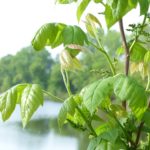
Poison Ivy loves edges
This summer millions of Americans will have unhappy encounters with poison ivy. For most people, the result is a patch of itchy bumpy skin that goes away after a few days to a week or so. Unfortunate others will develop a serious reaction that includes severe itching and swelling.
The very best way to not get a case of poison ivy is to avoid the plant and its culprit – urushiol, an oil that causes the allergic reaction. It’s on the plant’s leaves, in the vines and the sap.
Avoiding urushiol is a surefire way of avoiding a poison ivy rash, but many people have trouble identifying the plant. Fortunately, poison ivy has a secret. Knowing it helps people avoid the plant.
Poison ivy is an amazingly adaptable, hardy and confusing plant. It can be a low growing ankle high sprig, a shoulder high shrub, or a vine winding up to the top of a tall tree. The old saying “Leaves of three, let them be” is only partially helpful in identifying the plant. Usually, it does have leaves in groups of three but many animals love dining on poison ivy and are immune to its ill effects. So, a rabbit or deer may have eaten a leaf, giving the plant leaves of two! And many nonpoisonous plants have leaves of three.
Enter the plant’s secret. Poison ivy is a plant of the edge. It’s rare in the middle of a sun-soaked prairie or in a deeply shaded forest. The plant almost always hugs the edge of a habitat, especially if it gets partial sunshine.
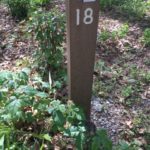
Birds drop seeds when they perch on campground posts.
We’ve seen poison ivy on the edges of:
- Lawns, including ours
- The ocean sand dunes
- Lakes, especially along trails
- Roads
- Trails anywhere
- Ballfields – the rough where balls sometimes go
- Picnic areas
- It especially seems to love life in state park campgrounds especially around the posts that mark a site number and the trees that shade a campground area and that kids love to hug!
So, to avoid poison ivy be especially cautious on the edge. Look carefully at edge plants and study photos of poison ivy in books and on the Internet. Avoid poison ivy when you can.
But, if you accidentally touch the plant or have been wading through likely habitat, get home soon, remove clothes carefully, avoiding touching the outsides of clothes where poison ivy sap may have touched, take a sudsy shower, toss the towels in the laundry, and odds are good that the oil will be soaped off before it creates an allergic reaction.
by Winding Pathways | Jan 25, 2018 | Mammals, Trees/Shrubs
Winter is the best time to spot dens and nests. Usually, we think of bird nests, and we see abandoned ones topped with mounds of snow along roadsides and in shrubs. When we look up, we also spot large clusters of leaves and sticks – squirrel nests.
Squirrels make two types of nests: dens and dreys. Dens are cavities in trees and dreys are the large balls of leaves and sticks that squirrels fashion. From the ground, these dreys look small, but they are really good sized.
Dens
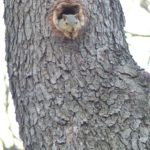
Taking in the view from the safety of a tree den.
When squirrel families mature in late summer, the young venture forth to find new lodgings. If the population of squirrels is low and the availability of hollows in trees is high, then squirrels take the dens. These are hollow spaces inside the trunk that squirrels line with leaves and bits of fur and bark. Squirrels do not create these hollows but use them. Wood rot and woodpeckers create the spaces and squirrels make the most of them. Dens offer great protection from the elements and predators and they are warmer. So, squirrels conserve their energy when they must “hole up” during winter storms. When the worst of the harsh weather passes, squirrels begin to stir, digging for nuts and raiding bird feeders.
Dreys

Squirrel Condominium
Squirrels make their dreys near sturdy forks in branches or close to the tree trunk. They will be high up for protection from predators. Usually, a tree might support one or two squirrel nests, but occasionally, we see half a dozen scattered throughout a wide-branching deciduous tree. Squirrel condominiums. These might be secondary homes or extensions of families. Secondary homes tend to be more loosely constructed and are scattered near the main home tree and serve as shelter in case a squirrel gets caught out in the elements or is being chased by a predator.
Each nest begins with a study base of twigs. Scientists have discovered that sometimes squirrels weave grapevines into the structure along with leaves, bark, moss, and twigs for added support. After all, the nest sways in the branches and get buffeted by winds, rain, and snow, so it needs to be strong. Inside, the nest is dry and warm.
When you are driving or walking look up and spot the nests of one of our most industrious small mammals. Squirrels mate in January and soon the young will be born – in the bleak mid-winter maybe in a squirrel condominium near you!
by Winding Pathways | Nov 9, 2017 | Nature, Trees/Shrubs
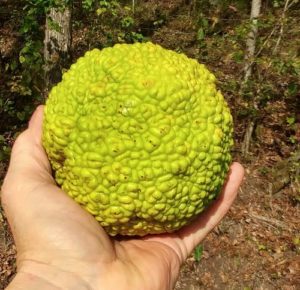 This fall we’ve noticed Osage Orange fruits for sale in grocery stores and roadside stands. They are fascinating and have a delightful fresh citrus scent.
This fall we’ve noticed Osage Orange fruits for sale in grocery stores and roadside stands. They are fascinating and have a delightful fresh citrus scent.
These are often called Hedge Apples, and many people call the tree they grow on Hedge. More properly the tree is called an Osage Orange and the fruits are Osage Oranges. To add confusion some people, call the tree Bodark because its springy tough wood was once used to make bows.
The Osage Orange once lived in a relatively small area of Texas and Oklahoma but because it is tough, drought resistant, and thorny it was commonly planted in places outside its native range. The tree’s branches twist in many directions with thorn-studded twigs. When planted in a row, the trees created a living fence that cattle wouldn’t cross. In the days before barbed wire was invented millions of Osage Oranges were planted for fences.
The wood is hard and heavy and is outstanding for firewood, but cutting it is challenging because of all the thorns.
Does a Hedge Apple in the basement keep insects away? Many people think so and annually buy or collect a few. We think it’s an ineffective way to keep out insects and find caulking entry points better for excluding bugs from our home.
In recent years an oil extracted from hedge apples has been used in shampoo and hair conditioners, and many people love the product. It is marketed as POMIFERA in honor of the tree’s Latin name Maclura pomifera. Todd Johnson, a native Bloomfield, Iowan, has cashed in on the Hedge Apple industry.
Hungry squirrels sometimes eat the seeds hidden inside hedge apples and livestock sometimes dine on them but they are inedible to humans.
There’s no harm in putting a few hedge apples in the basement but don’t count on them to keep away bugs.
by Winding Pathways | Jul 20, 2017 | (Sub)Urban Homesteading, Foraging, Nature, Trees/Shrubs
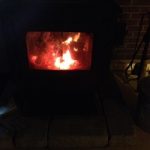
We love the cozy heat of wood burning in the woodstove.
Much of our heat at Winding Pathways comes from our two woodstoves. We love the cozy warmth given by our stoves but there’s more to it than just heat.
The wood we burn comes from trees that snatched carbon dioxide from the atmosphere in the past 100 years. Photosynthesis transformed carbon and water into wood, so we’re not contributing to global warming as much as if we burned coal, oil, or natural gas. And we get our wood free, thus helping the family budget.
Wood heat isn’t completely without cost. Each year we hire a company to clean and inspect our chimney and stove. So, we lay out some cash but far less than for conventional fuel. Wood heat also requires sweat equity to cut, stack and move firewood. At this point, it’s worth it. An added benefit is the security we feel when gazing at our six cords of stored wood. When storms shut down utilities we’ll stay warm.
Summer is an ideal time to prepare for autumn’s crisp nights.
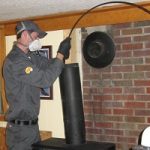
We have a professional chimney cleaner tend our chimney.In summer’s heat, we have our chimney cleaned. Chimney’s tend to accumulate build ups of a substance called creosote and soot. This build up can catch fire and ignite the entire house. Cleaning the chimney removes deposits and makes burning safer. We clean one chimney ourselves and hire a professional from Midtown Sweeps to clean a longer one that requires going up on our high roof. Chimney cleaning companies are located across the country and Midtown Sweeps has offices in many states. For information check them out. Don’t delay. As fall approaches cleaning companies get busy, so it’s best to have the chimney cleaned in the hot months of summer.
Burning the right type of wood properly yields the most heat and leads to minimal buildup of creosote. We get our wood free, and because we know how to find and choose firewood we keep cost and labor down. When choosing what wood to gather, cut, split, and burn it’s helpful to be able to identify the species of tree that the wood comes from. Every species yields a different amount of heat. Assuming the same level of seasoning, for example, a chunk of white oak yields about double the heat of a similar sized piece of basswood. By choosing high heat yielding wood labor and space needed to store wood is reduced. An outstanding way to learn relative heat value of most species of tree go to Chimney Sweep for a detailed chart. Many books and websites help with tree identification.
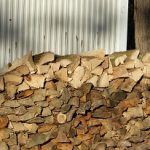
Stack wood in an airy place to cure.
To burn wood safely and hot, it needs to be cured. When we cut wood from a live, recently felled tree we split and stack it in an airy place sheltered from the rain. Place the wood up off the ground to promote air flow and reduce decay. The smaller the pieces the faster water will evaporate out of the wood. We prefer to season big chunks for 18 months but when properly stacked and split into relatively thin pieces, six months is usually adequate.
Two Scrounging tips:
- Sometimes scrounged wood is already seasoned. If the bark is off the tree and if the tree was dead and standing when it was cut down it’s likely the wood is already seasoned for burning.
- The best time for finding free firewood is during summer’s hot days when no one else is competing for firewood. The worst time to find free wood, especially seasoned wood, is during winter when competition is intense.
Winding Pathways Sources of Free Firewood
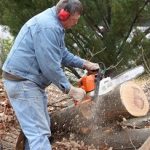
Wear protective gear when bucking up wood.
Our firewood comes from these sources that are generally available to most Americans:
YARDS. Whenever we cut or trim a tree we cut up the wood and put it in storage. Few of our neighbors burn wood and are happy to give us theirs when a tree breaks or is felled. We are also urban wood scroungers and when we find a chunk that’s fallen off a truck we collect it and add it to our woodpile. It’s surprising how much wood is available by simply being observant. After storms, home owners often drag bucked up limbs to the street edge, where they are free for the taking.
WOOD DUMP: Our city, Cedar Rapids, dumps sections of trees it has removed from streets and parks in a place they call THE WOOD DUMP. Sign a liability release form and the City welcomes anyone to remove as much wood as they’d like. It saves our town the cost of disposal and puts the wood to good use. Other cities may have similar programs. Call the town clerk or access their website for information.
SCRAP HEAP: Several nearby companies pile broken pallets and crates near their parking lot and let people scrounge wood. Mostly these are made of pine or spruce. It’s great for kindling to start fires but not for sustaining a vigorous burn. However, we sometimes find pallets made of ash, elm, or even oak. Often these include 2″x 4″ chunks, which do provide outstanding heat. We cut up pallet wood using a circular saw with a carbide blade. Use safety equipment and be careful of nails.
Get going now. Have the chimney cleaned and inspected in summer and have a shed filled with seasoned firewood before the first frosty autumn night.
Winding Pathways has no relationship, other than as a customer or user, to companies or information sources noted in this blog.
by Winding Pathways | May 21, 2017 | (Sub)Urban Homesteading, Foraging, Nature, Trees/Shrubs
This is a tale of free trees. Our friend, Marilynn Keller, learned how to plant the best tree species in her yard at no cost and with little work.
She simply didn’t mow a tiny area of lawn where she wanted a tree to grow. As if by magic, a White Oak, Sugar Maple, and Shagbark Hickory sprouted there this spring. Although the spot is too small for three trees Marilynn can simply decide which one she wants and mow the others off.
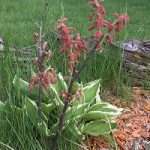
Likely a squirrel buried a nut that has sprouted.
Last fall an industrious squirrel gathered acorns and hickory nuts and buried them in her yard. The squirrel might have forgotten his hidden cache or perhaps died. Either way the unrecovered nuts sprouted.
Although squirrels often eat maple seeds, it’s most likely that Marilynn’s baby maple sprouted because a gust of wind pulled the ripe seed off a nearby tree and it helicoptered to her yard.
While Maples are usually easy to transplant, and are widely sold by nurseries, not so Hickories. Although any of the many Hickory species make outstanding shade trees, as soon as a nut sprouts it sends an enormous taproot deep into the ground. Moving a hickory is difficult and often unsuccessful. Commercial nurseries avoid them.
The same goes for white oaks, one of our favorite trees. It’s difficult to buy one to plant in the yard. Because they are slow growing and challenging to transplant, few nurseries bother with them. Fortunately, they readily sprout on their own.
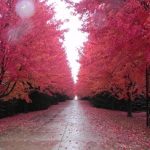
In autumn Maples glow with color.
Anyone living where there are mature Hickory, Oak, or Maple trees nearby can use Marilynn’s tree planting method. Simply don’t mow a patch of lawn where a tree is desired. Odds are one will appear on its own next spring. If more sprout than the spot can support just mow the others off and put wire screening around the new tree to protect it from hungry cottontails and deer.
If a tree sprouts in the wrong place it can be easily transplanted with just one shovel of dirt. Move it before the tiny tree has grown a long taproot.
by Winding Pathways | May 16, 2017 | (Sub)Urban Homesteading, Garden/Yard, Nature, Trees/Shrubs
We never spray our lawn at Winding Pathways. Occasionally, that yields an exciting discovery like what happened in early May.

Rich shows the tiny oak seeding.
We wanted to plant a tree, preferably an oak, on the south side of our garage. But, we got busy and never found time to buy or plant one. One morning Rich, while walking across the lawn to fetch the morning newspaper, spotted a baby white oak tree that sprouted exactly where we wanted to plant one. It was serendipity.
Seed Banks”
Plant ecologists talk about the “seed bank.” In land that hasn’t been greatly disturbed by plowing, spraying or compacting of soil, seeds of desirable native plants often remain dormant in the soil for years or decades. Then, when conditions are right they’ll sprout like magic. Other desirable plants spread their seed through the wind or enlist the help of a hungry squirrel to carry and bury a nut or acorn. That’s probably how our new oak got planted.
Before mowing walk across your unsprayed lawn. You may discover a plant you want that is starting to grow. Just mow around it to let it thrive. Mark it with a stake or fence it off from rabbits and deer. If the plant is not quite in the right place, remember that tiny plants are usually easy to move with just a shovel full of dirt.
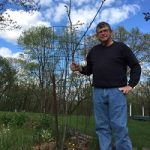
We protect volunteer trees that grow where we want them.
About seven years ago we found another baby oak in our lawn. We protected it from mowing and ran a screen around it to keep hungry deer away. It’s now about seven feet tall and growing rapidly.
That black oak didn’t cost a penny and will grace our yard long after we’re gone.
Another way to go about natural or plant and wildlife friendly yards is to deliberately plant certain forbs and grasses to attract a variety of beneficial insects and interesting birds and other wildlife.





 This fall we’ve noticed Osage Orange fruits for sale in grocery stores and roadside stands. They are fascinating and have a delightful fresh citrus scent.
This fall we’ve noticed Osage Orange fruits for sale in grocery stores and roadside stands. They are fascinating and have a delightful fresh citrus scent.






